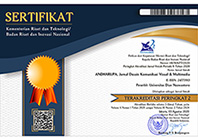A FRAMEWORK TO DESIGN MASCOT CHARACTER AS SUPPORTING TOOL FOR CITY BRANDING BASED ON YURU-CHARA CONCEPT
Abstract
Abstrak
Pemanfaatan maskot, yang juga disebut "Yuru-chara", untuk place branding. adalah hal yang biasa dilakukan di Jepang. Dalam beberapa kasus, seperti Kumamon yang digunakan sebagai maskot kota Kumamoto, terbukti sukses. Beberapa tahun terakhir kota-kota di Indonesia seperti Surabaya, Malang, dan Balikpapan telah mencoba menggunakan maskot dalam membentuk citra kotanya. Meski demikian, sebagian besar maskot tersebut tidak diterima dengan baik oleh masyarakat. Penelitian ini bertujuan untuk menemukan kerangka kerja praktis dalam merancang maskot yang efektif untuk city branding yang menarik bagi publik dan merepresentasikan kota dengan baik. Framework tersebut dibuat dengan mengadopsi pendekatan desain yang digunakan untuk mendesain Yuru-chara di Jepang dengan menggunakan Metodologi Penelitian Desain. Hasilnya, kerangka kerja desain yang terdiri dari empat tahap, yaitu 1) menentukan pesan, (2) membuat penamaan, (3) mendesain, (4) menciptakan dan memelihara visibilitas dapat dikembangkan. Berdasarkan evaluasi yang dilakukan oleh para desainer dan ahli, ditemukan bahwa framework tersebut dapat dimengerti dan berguna untuk menciptakan desain maskot yang menarik, tetapi memiliki kelemahan untuk memenuhi tujuan city branding. Sebagai rekomendasi, perlu ditambahkan tahapan penelitian yang mendalam sebagai proses pendefinisian pesan yang digunakan sebagai dasar ide desain.
Kata Kunci: yuruchara, desain maskot, desain karakter, city branding, metode desain
Abstract
The utilization of a mascot called “Yuru-chara” for place branding is a common practice in Japan. In several cases, for instance, Kumamon, the mascot of Kumamoto city proven to be successful. In recent years, cities in Indonesia such as Surabaya, Malang, and Balikpapan have tried to use mascots in their city branding. Nevertheless, most of the mascots are not well-received by the public. This research intends to find a practical framework to design an effective mascot for city branding that is appealing to the public and properly represents the city. The framework is created by adopting the design approach that is used for designing Yuru-chara in Japan, using Design Research Methodology. As a result, a design framework that consists of four phases, which are 1) specifying message, (2) creating naming, (3) designing, (4) creating and maintaining visibility to developed. Based on the evaluation performed by designers and experts, it is discovered that the framework is understandable and useful for creating appealing mascot design, but has a weakness to fulfill the city branding purpose. As a recommendation, an in-depth research phase needs to be added as a process for defining the message used for the basis of the design idea.
Keywords: yuru-chara, mascot design, character design, city branding, design method
Full Text:
PDFReferences
Blessing, L. T. M., & Chakrabarti, A. (2009). A Design Research Methodology. Springer Dordrecht Heidelberg.
Esmaeilpour, F., & Nashtaee, M. S. (2020). Stereotyping and advertising characters/mascots. In Food Advertising and Childhood Obesity (p. 13).
Inoue, H., & Fujisaki, Y. (2018). Impression space analysis of local mascot characters for regional promotion. Journal of Advanced Computational Intelligence and Intelligent Informatics.
Jojic, S. (2018). City Branding and the Tourist Gaze: City Branding for Tourism Development. European Journal of Social Science Education and Research, 5(3).
Nakasato, Y., & Tanaka, T. (2017). Analysis and prediction of “Yuru-Chara” mascot popularity using visual and auditory features. IEEE International Conference on Multimedia & Expo Workshops (ICMEW), 489–494.
Nittono, H. (2016). The two-layer model of ‘kawaii’: A behavioural science framework for understanding kawaii and cuteness. East Asian Journal of Popular Culture.
Occhi, D. J. (2010). Consuming Kyara Characters Anthropomorphization and Marketing in Contemporary Japan. Comparative Culture, the Journal of Miyazaki International College, 15, 78–87. https://meilib.repo.nii.ac.jp/?action=pages_view_main&active_action=repository_view_main_item_detail&item_id=119&item_no=1&page_id=24&block_id=45
Occhi, D. J. (2012). Wobbly aesthetics, performance, and message comparing Japanese kyara with their anthropomorphic forebears. Asian Ethnology, Volume 71(1), 09–132. https://asianethnology.org/downloads/ae/pdf/a1741.pdf
Paliaga, M., Franjic, Z., & Strunje, Z. (2010). Methodology of valuation of cities’ brands. Economic Research, 23(2), 102–111.
Radomskaya, V., & Pearce, P. L. (2020). Adding character: The role of destination mascots in tourism development. Tourism Management.
Sakamoto, M. (2017). Exploring tactile perceptual dimensions using materials associated with sensory vocabulary. Frontiers in Psychology, 8.
Soltani, A., Pieters, J. G., Young, J. O., & Zhaohong, S. (2017). Exploring City Branding Strategies and Its Impacts on Local Tourism Success. Asia Pacific Journal of Tourism Research, 23(1).
Suter, J. R. (2016). Who Is Hikonyan? The Phenomenon of Japanese Yuru-Chara. Sociology Study, 6(12), 775–782.
Wattanacharoensil, W., Kantamara, S., & Muangasame, K. (2020). An investigation of the Kumamon and Sukjai mascots on destination branding. Journal of Place Management and Development.
Wheeler, A. (2017). Designing Brand Identity: An Essential Guide for The Whole Branding Team 5th Edition. John Wiley & Sons.
Yu, E., & Kim, J. (2020). The relationship between self-city brand connection, city brand experience, and city brand ambassadors. Sustainability (Switzerland).
DOI: https://doi.org/10.33633/andharupa.v7i01.4379
Article Metrics
Abstract view : 1538 timesPDF - 945 times
Refbacks
- There are currently no refbacks.
indexed by:
Andharupa Journal (p-ISSN: 2477 - 2852 | e-ISSN: 2477 - 3913) is published by Dian Nuswantoro University, Semarang. This Journal is licensed under Creative Commons Attribution 4.0 International License.
























